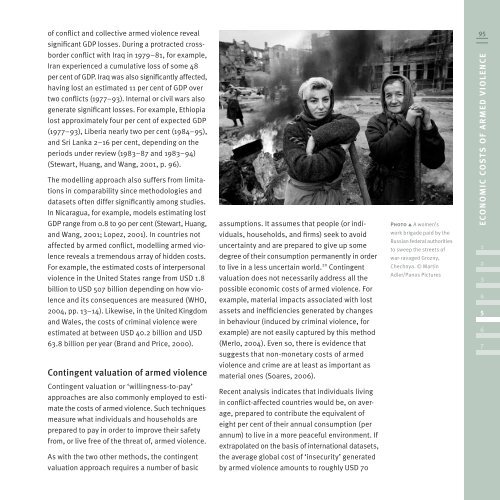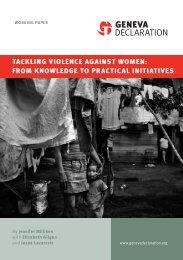Global Burden of Armed Violence - The Geneva Declaration on ...
Global Burden of Armed Violence - The Geneva Declaration on ...
Global Burden of Armed Violence - The Geneva Declaration on ...
Create successful ePaper yourself
Turn your PDF publications into a flip-book with our unique Google optimized e-Paper software.
<str<strong>on</strong>g>of</str<strong>on</strong>g> c<strong>on</strong>flict and collective armed violence reveal<br />
significant GDP losses. During a protracted crossborder<br />
c<strong>on</strong>flict with Iraq in 1979–81, for example,<br />
Iran experienced a cumulative loss <str<strong>on</strong>g>of</str<strong>on</strong>g> some 48<br />
per cent <str<strong>on</strong>g>of</str<strong>on</strong>g> GDP. Iraq was also significantly affected,<br />
having lost an estimated 11 per cent <str<strong>on</strong>g>of</str<strong>on</strong>g> GDP over<br />
two c<strong>on</strong>flicts (1977–93). Internal or civil wars also<br />
generate significant losses. For example, Ethiopia<br />
lost approximately four per cent <str<strong>on</strong>g>of</str<strong>on</strong>g> expected GDP<br />
(1977–93), Liberia nearly two per cent (1984–95),<br />
and Sri Lanka 2–16 per cent, depending <strong>on</strong> the<br />
periods under review (1983–87 and 1983–94)<br />
(Stewart, Huang, and Wang, 2001, p. 96).<br />
<str<strong>on</strong>g>The</str<strong>on</strong>g> modelling approach also suffers from limitati<strong>on</strong>s<br />
in comparability since methodologies and<br />
datasets <str<strong>on</strong>g>of</str<strong>on</strong>g>ten differ significantly am<strong>on</strong>g studies.<br />
In Nicaragua, for example, models estimating lost<br />
GDP range from 0.8 to 90 per cent (Stewart, Huang,<br />
and Wang, 2001; Lopez, 2001). In countries not<br />
affected by armed c<strong>on</strong>flict, modelling armed violence<br />
reveals a tremendous array <str<strong>on</strong>g>of</str<strong>on</strong>g> hidden costs.<br />
For example, the estimated costs <str<strong>on</strong>g>of</str<strong>on</strong>g> interpers<strong>on</strong>al<br />
violence in the United States range from USD 1.8<br />
billi<strong>on</strong> to USD 507 billi<strong>on</strong> depending <strong>on</strong> how violence<br />
and its c<strong>on</strong>sequences are measured (WHO,<br />
2004, pp. 13–14). Likewise, in the United Kingdom<br />
and Wales, the costs <str<strong>on</strong>g>of</str<strong>on</strong>g> criminal violence were<br />
estimated at between USD 40.2 billi<strong>on</strong> and USD<br />
63.8 billi<strong>on</strong> per year (Brand and Price, 2000).<br />
C<strong>on</strong>tingent valuati<strong>on</strong> <str<strong>on</strong>g>of</str<strong>on</strong>g> armed violence<br />
C<strong>on</strong>tingent valuati<strong>on</strong> or ‘willingness-to-pay’<br />
approaches are also comm<strong>on</strong>ly employed to estimate<br />
the costs <str<strong>on</strong>g>of</str<strong>on</strong>g> armed violence. Such techniques<br />
measure what individuals and households are<br />
prepared to pay in order to improve their safety<br />
from, or live free <str<strong>on</strong>g>of</str<strong>on</strong>g> the threat <str<strong>on</strong>g>of</str<strong>on</strong>g>, armed violence.<br />
As with the two other methods, the c<strong>on</strong>tingent<br />
valuati<strong>on</strong> approach requires a number <str<strong>on</strong>g>of</str<strong>on</strong>g> basic<br />
assumpti<strong>on</strong>s. It assumes that people (or individuals,<br />
households, and firms) seek to avoid<br />
uncertainty and are prepared to give up some<br />
degree <str<strong>on</strong>g>of</str<strong>on</strong>g> their c<strong>on</strong>sumpti<strong>on</strong> permanently in order<br />
to live in a less uncertain world. 20 C<strong>on</strong>tingent<br />
valuati<strong>on</strong> does not necessarily address all the<br />
possible ec<strong>on</strong>omic costs <str<strong>on</strong>g>of</str<strong>on</strong>g> armed violence. For<br />
example, material impacts associated with lost<br />
assets and inefficiencies generated by changes<br />
in behaviour (induced by criminal violence, for<br />
example) are not easily captured by this method<br />
(Merlo, 2004). Even so, there is evidence that<br />
suggests that n<strong>on</strong>-m<strong>on</strong>etary costs <str<strong>on</strong>g>of</str<strong>on</strong>g> armed<br />
violence and crime are at least as important as<br />
material <strong>on</strong>es (Soares, 2006).<br />
Recent analysis indicates that individuals living<br />
in c<strong>on</strong>flict-affected countries would be, <strong>on</strong> average,<br />
prepared to c<strong>on</strong>tribute the equivalent <str<strong>on</strong>g>of</str<strong>on</strong>g><br />
eight per cent <str<strong>on</strong>g>of</str<strong>on</strong>g> their annual c<strong>on</strong>sumpti<strong>on</strong> (per<br />
annum) to live in a more peaceful envir<strong>on</strong>ment. If<br />
extrapolated <strong>on</strong> the basis <str<strong>on</strong>g>of</str<strong>on</strong>g> internati<strong>on</strong>al datasets,<br />
the average global cost <str<strong>on</strong>g>of</str<strong>on</strong>g> ‘insecurity’ generated<br />
by armed violence amounts to roughly USD 70<br />
Photo ! A women’s<br />
work brigade paid by the<br />
Russian federal authorities<br />
to sweep the streets <str<strong>on</strong>g>of</str<strong>on</strong>g><br />
war-ravaged Grozny,<br />
Chechnya. © Martin<br />
Adler/Panos Pictures<br />
95<br />
ECO N OMIC COS T S OF A R M E D V I O L E N C E<br />
1<br />
2<br />
3<br />
4<br />
5<br />
6<br />
7









